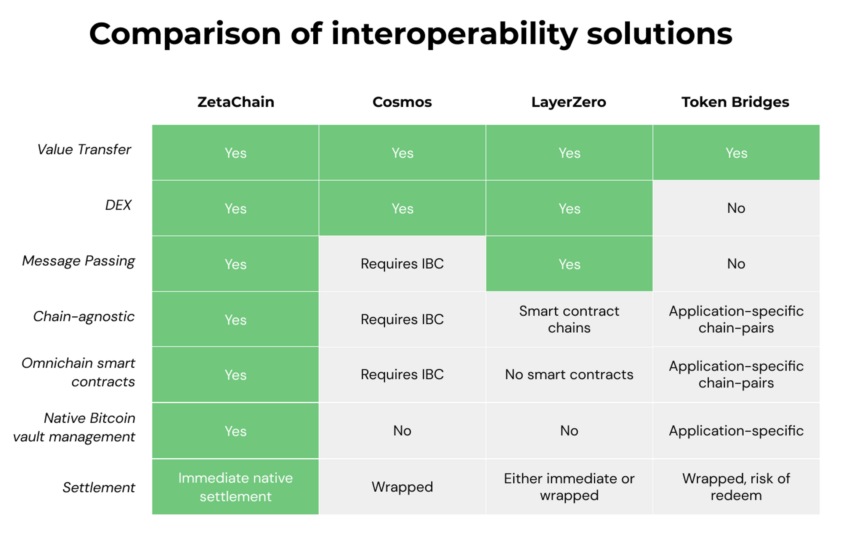Interoperability: We must solve the lack of interoperability among blockchains, says Brandon Truong, Head of Product at ZetaChain.
The rapid growth of blockchain technology has led to a highly complex multi-chain ecosystem. With trade-offs around security, decentralization, scalability, cost, etc., it’s difficult to imagine that just one of these single blockchains would meet all of our society’s needs. As long as multiple chains exist, the demand for value flow between them will persist.
The issue of today’s blockchains is that they’re designed to be closed environments. Such fragmentation creates immense barriers for users to fluidly adopt and experience the benefits of other chains. If we want to see mass adoption of innovative web3 technologies and open the global financial system, then we must solve the lack of interoperability among blockchains.
A number of proposals and projects emphasize the ability to inter-operate, however, the majority of interoperability systems only apply to specific blockchains. Moreover, they contain standardized protocols that other blockchains must adopt through complicated, restricted, and/or less secure bridges.
Interoperability: Cross-blockchain Strategies
Several cross-chain strategies are used to increase levels of interoperability (side-chains, relays, notary schemes, hash time-lock contracts, and blockchains of blockchains), but the underlying fragmentation issue persists. Blockchains are inherently closed systems, which makes it difficult to bring reliable external information to the chain without a trusted third party (oracle) such as a centralized exchange. To date, no decentralized, permissionless, and public service facilitates atomic transactions that involve multiple blockchains.
Let’s examine these main cross-chain strategies. First, side-chains/relays solutions implement bridges that primarily enable portable assets from one chain to another. Rather than rely on a trusted intermediary, chain B implements a thin client of chain A using smart contracts to trustlessly verify events that occurred on chain A. Examples of relays include the BTCRelay on Ethereum and the Rainbow bridge of Ethereum on the NEAR blockchain.
Second, notary schemes are mechanisms where a trusted entity (or set of) is tasked with notarizing claims such as event X has happened on blockchain A. While obvious examples are centralized exchanges, notary schemes can be decentralized such as the Interledger project and THORChain.
Third, hash time-lock contracts (HTLC) are constructs of smart contracts that can facilitate atomic swaps across chains trustlessly without additional trust beyond the participating two blockchains. Examples of HTLC include XClaim BTC/Ethereum or BTC/Polkadot bridge, and the Lightning Network on Bitcoin.
Fourth, blockchains of blockchains (BoB) are frameworks that provide data, network, consensus, incentive, and contract layers for constructing application-specific blockchains that inter-operate with each other. Note that BoB does not solve current interoperability problems directly. For example, to connect to legacy chains, some sort of bridge or other mechanism described above must be employed. Important examples of BoB are Polkadot and Cosmos.
Each of these broad strategies has its strengths and weaknesses in technical complexity, trust assumptions, level of interoperability, and use cases. Our discussion here is brief and incomplete, but still, we can roughly categorize the characteristics of these strategies; see Table 1 for a comparison.

Interoperability Related Work
Cross-chain Communication
A basic building block of any cross-blockchain interoperability is the ability to communicate and prove to chain B that a certain transaction happened on chain A.
- BTCRelay, Rainbow Bridge: In a one-way bridge on Ethereum from Bitcoin, a user on Bitcoin sends 1 BTC to a given custody address, and then receives one wrapped BTC issued on Ethereum. BTCRelay is a smart contract that can trustlessly verify the transaction on bitcoin, and issue a corresponding wrapped BTC coin on Ethereum. An Ethereum smart contract can verify the transaction on Bitcoin through a Merkle proof. The Rainbow Bridge is also a good example of a bridge between Ethereum and NEAR. These kinds of bridges are strong and trustless, but rather expensive to operate.
- Wormhole: Wormhole is also a cross-chain message delivery service, but it’s not trustless because it depends on a set of validator nodes to attest to the validity of the message delivered. Let’s take the same example above, except this one-way bridge is on Ethereum from Solana. When a user sends 1 SOL to a certain custody address, one wrapped SOL is issued on Ethereum. The Ethereum smart contract does not verify the transaction on Solana in order to issue the wrapped coin; it trusts that the super majority of the set of Wormhole validators are honest and correct. It appears that Wormhole relies on reputations of validators to build trust.
- LayerZero: LayerZero is a communication layer for facilitating cross-chain message delivery. In our terminology and categorization, LayerZero is not trustless due to the trust needed for the independence of two parties (relayer and oracle). If they collude, they can defraud LayerZero by making up an invalid block header, and make chain B believe that a non-existent transaction has happened on chain A. LayerZero essentially outsources their security to third-party relayer and oracle.
- IBC: Inter-Blockchain Communication (IBC) protocol is a TCP/IP-like protocol for communication between sovereign blockchains. For the blockchains that support IBC, they can establish connections, and through these connections, one blockchain can verify proofs against the consensus states of another blockchain via a light client. Among the blockchains that support IBC, very strong interoperability can be established, such as coin transfer, atomic swaps, cross-chain decentralized exchanges, and even cross-chain smart contracts. The major drawback of IBC is that it requires adoption, which is a lot to ask of other blockchains, and also might not be possible for legacy blockchains.
Cross-blockchain Asset Transfer
- Hop: Hop is a protocol to send coins across rollups and their underlying L1 in a trustless manner. Rollups are by default siloed systems and the asset transfer between rollups and L1 can be slow and expensive. Hop solves the problem of moving coins across rollups by creating bridges and bridge coins and uses AMM markets to exchange coins rather than sending coins directly.
- Connext: Connext is a trust-minimized solution for cross-chain asset swaps. The idea is somewhat like generalized atomic-swaps, using Hash Time Locked Contracts (HTLC) to ensure transaction atomicity. Compared to Hop, Connext uses off-chain services and therefore can connect beyond rollups on a single L1; compared to externally verified solutions, Connext is application specific and not general purpose. For example, it cannot be adapted to send arbitrary messages or cross chain contract calls.
- Multichain: Multichain (previously Anyswap) is a cross-chain bridge and cross-chain router network. The network consists of smart contracts on connected chains, and the Fusion network. The key technology is distributed TSS key among MPC nodes, and DCRM (Distributed Control Rights Management). It appears that Multichain is a bridge that locks coins on connected chains and wraps them on the Fusion blockchain. Multichain can therefore be considered as a centralized bridge.
- THORChain, Sifchain, Chainflip: THORChain (along with similarly built competitors like Sifchain and Chainflip) is a decentralized liquidity network that facilitates AMM style native L1 coins on different blockchains, including Bitcoin, Litecoin, Bitcoin Cash, Ethereum. Notably, THORChain is not, strictly speaking, a bridge, as it does not lock & wrap coins and transact on wrapped coins. Rather, THORChain is an application-specific blockchain that maintains the pool, logic, and management of vaults on different chains for swapping. ZetaChain is in-part inspired by the design of THORChain, and can be thought of as a simpler and more generalized platform which enables not only swapping, but a generic smart contract platform that allows arbitrary cross-chain applications to be built easily.

Cross-blockchain Smart Contract
- Quant Network: Functionality-wise, the Quant network and its Overledger is the closest to ZetaChain. The Quant network is a centralized service that provides access to the connected public or private blockchains. It supports general programmability triggered by events on those blockchains (transaction to/from a given address, smart contract interaction, events, state changes, etc.), via popular languages and frameworks such as Javascript, Java, Python, etc. ZetaChain aims to achieve similar general programmability, but with an incentivized public blockchain, with far reduced trust assumptions, more transparency, complete verifiability and auditability.
- ICP/Chain-Key: The Internet Computer Protocol (ICP) has proposals to enable interoperability to the Bitcoin network via its Chain-Key technology, which is similar to the distributed threshold signature scheme. With Chain Key, ICP in principle can custody funds on the Bitcoin network. It’s unclear how ICP observes the Bitcoin network, and how their smart contract platform interacts with external blockchains
- HyperService: HyperService proposes a cross-chain smart contract platform that is chain agnostic. It consists of two components: a high level language HSL to describe a cross-chain dApp, and an execution layer that ensures financially atomic transactions.
Blockchain of Blockchains (BoB)
- Polkadot, Cosmos: The most prominent BoBs are Polkadot and Cosmos. Polkadot, for example, provides a relay chain which handles all consensus, and Parachains which can be different blockchains with different state-transition functions. The Parachains are tightly integrated and can inter-operate seamlessly via the relay-chain. The Cosmos ecosystem, on the other hand, does not share consensus, so the interoperability between Cosmos chains is less tight. Every Cosmos chain is sovereign with their own choice of consensus (typically Tendermint-based fast finality). The Cosmos ecosystem relies on the IBC protocol (see Cross-chain Communication section), and special blockchains called Hubs to facilitate cross-chain asset transfers, and even cross-chain smart contracts. To enjoy interoperability in Cosmos or Polkadot, the blockchains typically need to be built on some common ground. Legacy blockchains, or new blockchains with their own consensus, cannot be part of BoBs.
Decentralized, Public/Permissionless, Omnichain Interoperability
Current cross-blockchain interoperability approaches previously described include the ability to communicate, transfer assets, and even run more sophisticated programming logic cross-chain. Beyond message delivery and cross-chain transactions, however, the market lacks a public blockchain on top of which general, decentralized omnichain smart contracts can be easily built. The ability for these smart contracts to hold and manipulate assets on external chains directly is what we refer to as omnichain interoperability.
- ZetaChain: Built on the Cosmos SDK and Tendermint PBFT consensus engine, ZetaChain is a Proof of Stake (PoS) blockchain. Accordingly, it experiences fast block time (~5s) and instant finality. The ZetaChain architecture consists of validators, observers, and signers. Validators participate in block production and receive rewards proportional to their bonded staking coins, observers reach consensus on external chain events and states, and signers, in a distributed fashion, hold standard ECDSA/EdDSA keys to sign messages on behalf of ZetaChain. ZETA is one of the first multi-chain tokens natively issued across multiple chains and layers and represents the only native value transfer cross-chain via a one-way peg mechanism. ZetaChain’s general-purpose cross-chain smart contract platform enables omnichain application building such as 1.) cross-chain message passing with value/data of which many dApps can be built such as DEXs, borrowing/lending, multi-chain NFTS; 2.) smart contract managed external assets including non-smart contract capable blockchains; 3.) cross-chain AMM exchanges; 4.) multi-chain NFT ownership transfer.

The Takeaway
In this piece, we analyzed the landscape of cross-chain interoperability and discuss the downsides of existing approaches such as bridging. Different from emerging projects, ZetaChain proposes a blockchain with generic omnichain smart contract support that connects both smart contract blockchains such as Ethereum, Ethereum L2 rollups, Solana, Terra, and Algorand, and even non-smart contract blockchains such as Bitcoin and Dogecoin. Through a series of technological breakthroughs in decentralized, distributed computing, cryptography and protocol communication, ZetaChain establishes itself as the first blockchain that natively connects to all blockchains and layers.
About The Author:

Brandon Truong is head of Product at ZetaChain. ZetaChain is the foundational layer to a truly multichain future; the blockchain’s novel approach creates a fluid crypto-ecosystem that will enable more users, developers, and traders than ever to onboard, use, and take advantage of the benefits of crypto. ZetaChain’s blockchain enables multichain functionality without using bridges or wrapped tokens and enables the easy deployment of omnichain-dApps, or odApps, that can manage and connect data and value across all smart contract platforms as well as non-smart contract platforms like Bitcoin and Dogecoin.
Got something to say about blockchain interoperability, or anything else? Write to us or join the discussion in our Telegram channel. You can also catch us on Tik Tok, Facebook, or Twitter.
Disclaimer
In compliance with the Trust Project guidelines, this opinion article presents the author’s perspective and may not necessarily reflect the views of BeInCrypto. BeInCrypto remains committed to transparent reporting and upholding the highest standards of journalism. Readers are advised to verify information independently and consult with a professional before making decisions based on this content. Please note that our Terms and Conditions, Privacy Policy, and Disclaimers have been updated.


